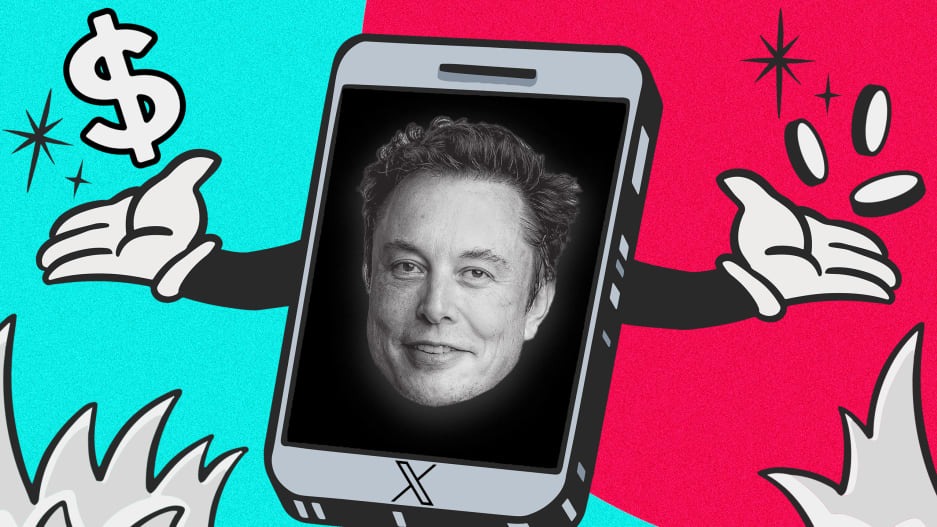- | 8:00 am
Elon Musk bought the wrong app
TikTok is on its way to becoming the everything app of Musk’s dreams.

Branded is a weekly column devoted to the intersection of marketing, business, design, and culture.
A popular social platform may be making real progress toward becoming an “everything app”—but it has nothing to do with Elon Musk or his rebranded X Corp. TikTok, which has been experimenting with e-commerce for months through its TikTop Shop, facilitating third-party sales, is now preparing to launch a more ambitious e-commerce business directly selling made-in-China goods to compete head-to-head with the popular shopping platforms, Shein and Temu.
This raises an interesting question: What if, while X futzes around with giant, problematic signage and other widely mocked theatrics, TikTok does an end run to become the everything app of Musk’s fever dreams?
Yes, it’s a long shot that any app can pull off this trick, and TikTok clearly faces special challenges (more on both those points to follow). But at least from a brand perspective, TikTok’s potential expansion is surprisingly plausible—in a way that, in fact, just underscores how X is actually moving in the opposite direction.
For starters, TikTok is a wildly popular and widely recognized brand, with close to 1.2 billion monthly users worldwide, and growing. Moreover, commerce is already threaded through its discourse. It’s not just “influencers” dropping (paid) references to brands, as well as straight-up advertising. TikTok users’ viral antics already boost sales of everything from music to purple shakes. So there’s at least a defensible logic to adding direct shopping to the mix. And once users get comfortable paying for things with TikTok, it’s easier to imagine testing what else they’d be willing to do with the app. In short, TikTok’s brand is inherently mass, inclusive, and built to expand.
The X story is different. Twitter was, of course, an incredibly well-known brand—but that hard-won equity has been replaced by a confusing new identity. Its actual user numbers were already more modest (a bit less than 400 million monthly); and under Musk, the vibe has gotten more niche, with a series of policy and design choices that ostensibly prioritize freedom of expression, but have alienated more users and advertisers than they’ve attracted. There could be a business model in there somewhere, but it’s not one that suggests expansiveness. The upshot is that, right now, X seems to be hoping users will conclude: “Now that Twitter is more tolerant of hate speech, I think I’d like to do my banking there.” Not likely.
That said, the entire goal of building an “everything app” for the U.S. market may be misguided. While WeChat in China, KakaoTalk in South Korea, and Line in Japan offer “super app” functionality ranging across communication and finance, those all evolved in different cultural and regulatory contexts. Aside from Musk, top executives at Meta, Snapchat, and even Uber have mused about building a U.S.-based equivalent, a one-stop app as an operating system for daily life. But efforts to make that a reality have so far gone nowhere.
TikTok has not expressed such an ambition, but even its step toward doubling down on commerce highlights its own unique challenges. The app has been experimenting with a tap-here-to-buy function in several countries since last year; but in the U.S., it had to revise plans that initially relied more on third-party sellers when many proved reluctant to sign on while politicians entertained various possible scenarios for banning the app, according to The Wall Street Journal. So the new plan, said to be rolling out this month, involves working more directly with merchants and manufacturers in China (and, over time, elsewhere), with TikTok itself storing and shipping a variety of consumer goods, from clothing to gadgets. It’s comparable to Amazon.com’s “Sold By Amazon” setup—and, of course, to the models of popular shopping platforms Temu and Shein.
Lately, the political clamor to ban or assert control over TikTok in the U.S. seems to have faded a bit. And in any case, its users have so far seemed to shrug off any fears of their data and behavior being potentially monitored by the Chinese government. But that could change—or at least become a more serious consumer concern if TikTok starts demanding credit card information and the like. It’s possible that an audience seeking dopamine-hit videos just won’t convert to shoppers—or will be turned off if it starts to feel like QVC. Plus, while Temu and Shein have smaller user bases, they are formidable and established competitors.
Nevertheless, the company is reportedly projecting $20 billion in gross sales from the new “shopping center” in its first year. That wouldn’t make it the everything app overnight, but it’s a potential step in that direction—and one that could make sense. Maybe at first blush, it seems a stretch to connect silly pet videos and purple-shake memes to financial transactions, but adding a little more commerce to a popular entertainment platform isn’t the worst strategy to make that happen. (Indeed, TikTok is already experimenting with buy-now, pay-later financing functionality with its marketplace option in Malaysia.)
It certainly makes more sense than an arbitrary rebrand connected to a platform increasingly known for divisiveness and controversy, and hoping to leverage the results into the mass audience that Twitter never achieved even at its peak. That plan is missing something. Let’s call it the X factor.





































